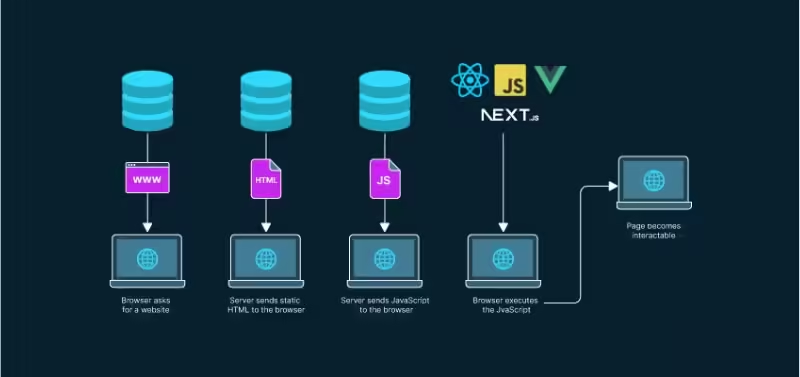As web applications grow increasingly complex, performance, scalability, and search engine optimization (SEO) become crucial elements of successful development. Server-Side Rendering (SSR), once a staple in the early days of the web, has re-emerged as a go-to strategy for delivering faster, more efficient web apps. With frameworks like Next.js, Nuxt.js, and SvelteKit, SSR is easier to implement than ever, and it plays a key role in optimizing user experience.
In this blog post, we’ll explore the best practices for implementing Server-Side Rendering in 2024, outlining how it enhances performance, improves SEO, and streamlines the development process for complex web applications.
What is Server-Side Rendering?
Server-Side Rendering (SSR) is the process where a web page is rendered on the server before being delivered to the browser. Instead of relying on client-side rendering (CSR), where the browser downloads JavaScript and renders the page on the user’s device, SSR sends a fully formed HTML page to the browser. This results in faster initial page load times and improved SEO because search engine crawlers can index pre-rendered content more easily.
Why SSR Matters in 2024
In 2024, web applications must prioritize both speed and performance to meet user expectations and improve engagement. SSR provides a range of benefits for modern web apps, including:
1. Faster First Paint: SSR delivers the fully rendered HTML to the client, enabling users to see content immediately, even on slow networks.
2. Improved SEO: Search engines can crawl and index the pre-rendered content more efficiently, which is particularly beneficial for content-heavy sites.
3. Enhanced Performance on Mobile Devices: SSR reduces the workload on lower-powered devices by offloading rendering to the server.
4. Reduced Time to Interactive: By sending pre-rendered HTML, users can start interacting with the content before the entire page is fully loaded.

Best Practices for Implementing Server-Side Rendering in 2024
1. Choose the Right Framework
To effectively implement SSR, choosing the right framework is critical. Here are a few leading frameworks that simplify SSR:
• Next.js (for React): One of the most popular SSR frameworks in the React ecosystem, offering built-in SSR capabilities, API routes, and serverless functions.
• Nuxt.js (for Vue.js): Provides an intuitive SSR setup for Vue.js projects with out-of-the-box features like automatic routing and server-side data fetching.
• SvelteKit (for Svelte): A relatively newer but highly efficient framework that handles SSR seamlessly, thanks to Svelte’s reactive architecture.
When choosing a framework, consider your app’s tech stack, team expertise, and scalability requirements.
2. Leverage Hydration for Dynamic Interactivity
After the server sends the fully rendered HTML, hydration re-attaches JavaScript functionality to the HTML elements on the client side, enabling interactivity. The key to efficient SSR is minimizing the initial JavaScript payload while maintaining seamless interaction once hydration is complete.
Best Practices for Hydration:
• Use code-splitting to reduce the amount of JavaScript sent to the client.
• Optimize hydration timing to prevent blocking the First Contentful Paint (FCP).
• Avoid heavy computations in the initial render that could delay hydration.
3. Optimize Data Fetching
One of the biggest challenges in SSR is efficiently fetching data before rendering the page. Poorly optimized data fetching can lead to increased server load and slower response times.
Best Practices for Data Fetching:
• Cache data wherever possible to reduce redundant server requests.
• Use asynchronous data fetching with technologies like React Suspense (for Next.js) or Apollo for GraphQL to handle server-side data efficiently.
• Take advantage of static generation for pages that don’t change frequently, as it combines the best of SSR and static site generation (SSG).
4. Implement Efficient Caching Strategies
Caching is essential for improving the performance of SSR applications, especially under heavy traffic. Well-configured caching ensures that frequently accessed content is delivered instantly without hitting the server every time.
Best Practices for Caching:
• Use HTTP caching headers like Cache-Control and ETag to manage client-side and CDN caching effectively.
• Employ Edge Caching with platforms like Cloudflare or Vercel to cache pages closer to users for faster delivery.
• Implement server-side caching with technologies like Redis to store frequently requested data or fully rendered HTML.
5. Minimize JavaScript Payloads
One of the challenges of SSR is the need to ship a minimal JavaScript payload to the client while maintaining a fast and interactive user experience.
Best Practices for Reducing JavaScript:
• Use Tree Shaking to eliminate unused code from your JavaScript bundles.
• Leverage code-splitting to load only the necessary JavaScript for each page, reducing the initial bundle size.
• Compress JavaScript and CSS files with tools like gzip or Brotli to minimize transfer sizes.
6. Optimize Server-Side Performance
Since SSR shifts the rendering workload to the server, it’s crucial to ensure your server can handle the increased demand without slowing down.
Best Practices for Server Optimization:
• Scale your server infrastructure dynamically with auto-scaling cloud platforms like AWS, Google Cloud, or Azure.
• Use load balancing to distribute traffic evenly across multiple servers.
• Consider using serverless functions for handling specific tasks without the overhead of managing a dedicated server.
7. Use Progressive Enhancement
With SSR, you can combine the best of both worlds: delivering fully rendered HTML for faster loads while progressively enhancing the page with JavaScript functionality.
Best Practices for Progressive Enhancement:
• Ensure your pages work without JavaScript for users with slow connections or who have disabled JavaScript.
• Use lazy loading for non-critical resources, such as images or additional components, to prioritize above-the-fold content.
The Future of SSR: Hybrid Rendering and Beyond
In 2024, SSR continues to evolve with the rise of hybrid rendering strategies that blend SSR, static site generation (SSG), and client-side rendering (CSR). Frameworks like Next.js offer Incremental Static Regeneration (ISR), allowing developers to serve statically generated pages and update them on-demand, delivering the best performance possible.
As the web becomes more dynamic and interactive, hybrid approaches will become the norm, offering a balance between performance and flexibility. This trend will make SSR an essential tool for building fast and scalable applications in the coming years.
Conclusion: Mastering SSR for Modern Web Apps
In 2024, mastering Server-Side Rendering is essential for web developers looking to build fast, scalable, and SEO-friendly applications. By implementing the best practices outlined in this guide—choosing the right framework, optimizing data fetching, leveraging caching, and reducing JavaScript payloads—you can significantly improve the performance of your web applications.
As the web development landscape continues to evolve, SSR will remain a critical strategy for delivering the high-performance experiences users expect.

